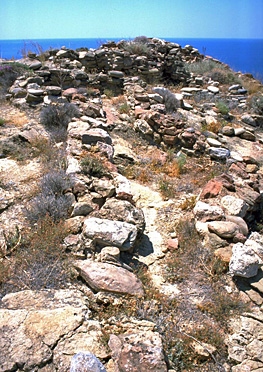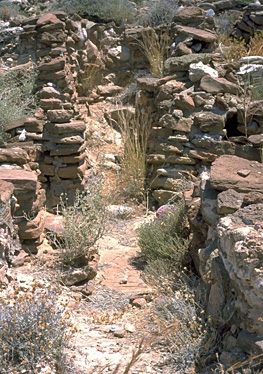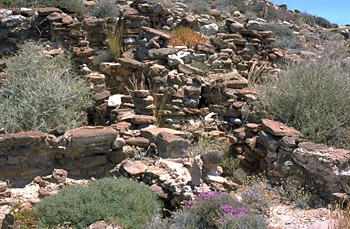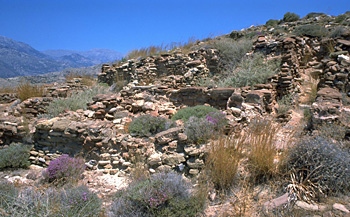A unique EMII settlement
This extremely important Early Minoan site is situated on the top and upper slopes of a steep hill, overlooking the Libyan sea, a few hundred metres from the present-day village of Myrtos and even closer to another Early Minoan site, Pyrgos, which lies between Fournou Korifi and the modern village. It is important because it belongs to only one period of Minoan history -- EM II -- and therefore gives vital information about this period which may not be so readily available at other sites where EM II deposits cannot be so clearly defined.
The site was excavated by Peter Warren in 1967 and fully published within a few years. Warren detected two distinct periods of development -- the first occurring in Early Minoan IIA and the second in Early Minoan IIB at the end of which the site was destroyed by fire. The first phase of development occupied a much smaller area than the second phase of about 100 rooms which Warren interpreted as a single communal settlement for about 100-120 people (perhaps a clan or extended family) living in one group without signs of hierarchy.
Alternative interpretations
Branigan, on the other hand, using the same evidence provided by Warren, interpreted the site as being the "mansion" of a local important person, a headman or chief. He also suggested that some of the highest rooms to the north end of the site, which were very small, had not be lived in but had been used to hold a series of tanks used in the washing and processing of wool in order to prepare it for the manufacture of clothing.
A radically different interpretation of the evidence was produced by Todd Whitelaw. He looked again at the way the site had originally been constructed and the use each of the rooms had been put to. As a result, he was able to reinterpret the site as having housed five or possibly six nuclear families with four to six members, making a likely total population of between 25 and 30. Each of the five or six "clusters" could be seen to have housed the same variety of activities -- cooking, specialised work activities like weaving, storage of produce, vessel storage, domestic rooms etc.
Whitelaw believes that the settlement grew slowly over time from an initial settlement of a single household while the small variation in the quality and quantity of materials found does not suggest a large status differential between the families living there.
The construction and maintenance of large walls around parts of the settlement suggest that on some matters the families worked together, though the evidence suggests that on a day to day basis the families were economically independent of each other. The fact that evidence was found for only two weaving looms might indicate, however, that specialised crafts were divided up between the families, all of whom would most certainly have been related to each other. It is not known how this settlement would have related to other settlements but certainly there would have been a need to for the young to marry people from outside the settlement.
The South House

Of the five or six houses identified by Todd the best preserved is the South House. The entrance was to room 74, the northermost room in the building, which was actually a corridor that was nevertheless put to use judging by the pottery finds there. The corridor led to Room 72 which was a small room used for storing small vessels. A dog-leg turn, a feature found frequently in Minoan architecture, gave access to the rest of the building. The very small Room 81 almost certainly had a weaving loom in it as loomweights were found there. Room 82 was also used as a storage area for pottery and foodstuffs. So the almost triangular area at the north of the house was where the daily activity of weaving and storage took place.
To the south of this area is an essentially rectangular area which was the living quarters of the family. The largest room in the house, room 80, would have been the main residential area. The room is so wide that there is a central support for the roof in the middle of the room. On the right hand side of the entrance to this room there was a small cupboard and although it was clearly the room the family lived in, there was neverthelss an area next to the south wall where a large number of storage vessels were found. Room 79 was yet another room given over to storage. Room 88 and possibly also room 79 were entered from the roof. Room 88 was the kitchen.
The house was almost certainly built in several phases using different materials during the various phases, e.g. some walls built entirely of stone, others built with mud bricks on a stone base.
Complexity in EM II
The site was so thoroughly excavated and reported, in comparison with other Early Minoan sites that there is no evidence from elsewhere to support the interpretation of Whitelaw, who looks to the Early Minoan tombs of the Messara for support for his view that the basic unit of social organisation in much of Early Minoan Crete was the nuclear family.
However, Whitelaw recognises that a small number of sites show evidence of much more complex social organisation including Mochlos, Phaistos, Mallia and Knossos. He points out that "it therefore becomes important to realise that there are qualititative (organisational) and not just quantitative (areal) differences between communities such as Myrtos and those represented by the Mesara tombs, and major sites, such as those that later developed into the palatial centres."
Despite claims that the Minoans lived in peace and did not need to build fortifications, it is interesting to note that Fournou Korifi, like Pyrgos and Trypiti -- also on the south coast -- is built on the top of a small, but steep, hill with good views in both directions along the coast.
PHOTOGRAPHS: Unfortunately the site has been completely overgrown on all occasions when I visited it, making it impossible, with very few exceptions, to photograph individual rooms. The site is fenced and is not generally open to the public.




